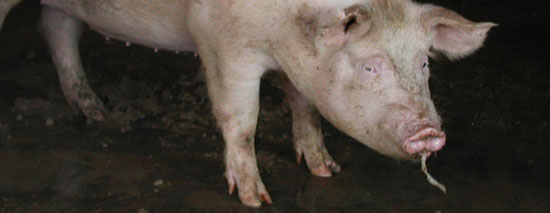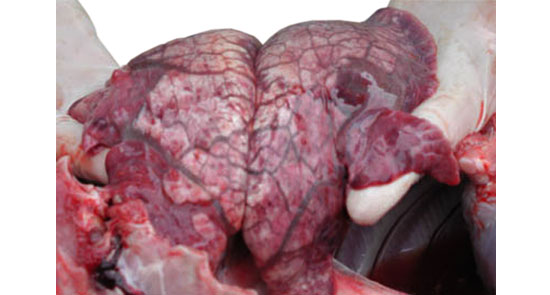Among the pathogens involved in PRDC, Mycoplasma hyopneumoniae (Mh) plays a key role in the development of damage due to this multifactorial syndrome because of its ability to induce secondary bacterial infections. In fact, bacterial pneumonia is the primary cause of mortality during the PRDC outbreaks, but the growth delay, the appearance of runt pigs and the increase of the treatment costs, are additional economic problems.

Figure 1. A case of acute PRDC in a heavy pig. The mucous exudate from the nose indicates the presence of a bacterial complication.
Vaccination in conjunction with strategic medication is known as an efficacious method to reduce clinical disease associated with M. hyopneumoniae infection, but these measures don’t prevent the Mycoplasmal colonization of the respiratory tract. So, a comprehensive and effective action must be based on providing good environmental conditions, in order to improve the natural host defenses and to maximize the effectiveness of applied solutions.

Improving the indoor air quality has become a priority in the modern pig farming and the use of bioactivators can be a very advantageous possibility. Bioactivators are compounds containing enzymes and selected bacterial cultures: these mixtures are able to decrease the development of volatile organic compounds (VOCs) responsible for odorous emissions from sewage.
VOCs come from a variation in the manure bacterial ecosystem which may alter the normal processes of degradation of organic compounds and modify the microflora balance increasing the ammonia production as well.
The mucosal surface of the respiratory-tract is normally covered with aqueous mucus. Many gases (such as NH3) are highly soluble in water and may pass from the breathed air in the mucus coating the airways. This process is enhanced by aerial dust that is usually present in livestock facilities.
An aerial concentration of ammonia between 15 and 25 ppm can be acceptable for growers and fatteners, while 50 ppm could modify the mucociliary clearance, causing coughing, sometimes dyspnoea and reducingweight increase.
The efficacy of bioactivators has also been demonstrated in reducing biogases emissions from manure with particular reference to ammonia. The bioactivators can be used as an aerosolized liquid or in powder form spread on the floors, according to pre-determined distribution schemes. Therefore, their regular and programmed use during the finishing phase could be able to reduce the ammonia concentration in the air of rearing facilities, lowering the pigs’ production losses due to PRDC.
During a study performed in Italy on bioactivation treated groups of heavy fattening pigs vs. control groups, the effect of a lesser air ammonia concentration (between 5 and 8 ppm) was clearly related to lower lung score (1.94 and 2.32) and to higher Average Body Weights (165.7 and 166.3 Kg) regardless of the high seroprevalence at slaughter time that confirmed the presence and the circulation of M. hyopneumoniae.
Better results were achieved when the liquid bioactivator was sprayed in facilities previously treated with powder on completely slatted floor: the application of both liquid and powder bioactivators allowed improved livestock performances and more homogeneous results. As a consequence of improved environmental quality even mortality is lower in the treated groups. The full results of the trial are reported in the table below.
Interestingly, better performances were obtained when pigs were housed on slatted floors, because the bioactivation system increases its efficacy against the development of ammonia biogas when it works in manure pits. This result could be a consequence of the higher presence of oxygen when the bioactivators are scattered on the floors. In fact, these compounds are more effective under anaerobic conditions which normally develop in manure pits.
| Group | Floor | Bioactivation treatment | Mortality % | Sero prevalence (%) | NH3 (ppm) | Average lung score | Slaughter average weight |
| Group1 | Slats | none | 2 | 57 | 30 | 4.76 | 162.30 |
| Group 2 | Slats | powder | 0.5 | 83 | 5 | 2.32 | 166.30 |
| Group 3 | Slats | powder + liquid | 0.8 | 93 | 8 | 1.94 | 165.70 |
| Group 4 | Concrete/ Slatted | powder + liquid | 0.7 | 87 | 12 | 2.90 | 159.86 |
| Group 5 | Concrete/ Slatted | powder | 1.3 | 79 | 20 | 3.20 | 158.16 |
Seroprevalence, lung scores, air quality and livestock performances of bioactivation treated and control groups. (All the differences are statistically significant)
The cost of the bioactivation treatment is 0,02 € / kg for a pig of 160 kg at ten months of life.
Environmental quality remains the cornerstone in the prevention of respiratory disease and production-related damage. However, a suitable environment for the animals can be achieved only by improving air quality and reducing the concentration of ammonia. To this end, the bioactivators could be an innovative method.




